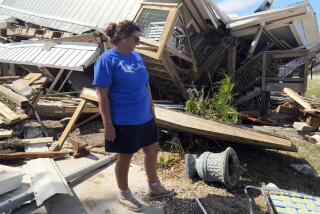After Mitch, Farmers Plot New Methods
- Share via
CHICHIGALPA, Nicaragua — Even as relief workers struggle to feed people stranded by the most destructive tropical storm in two centuries, Central American farmers are scrambling to save damaged crops for the longer term and focusing on new farming regions and methods.
From corn and bean farmers, whose small plots feed their countries, to banana, coffee and sugar cane plantations, whose exports will pay off loans needed to rebuild roads and bridges, Central Americans are plotting recovery.
Experts are lavishing attention on long-neglected areas that now offer hope for warding off hunger, and using the impulse provided by the emergency to address festering problems. Moreover, they are doing as much as they can within the rules of free-market economics by minimizing any hopes for subsidies and government intervention.
“This is the moment to take advantage of an opportunity to do things better, to use improved seeds, soil conservation techniques and to introduce new crops,” said Robert Rivera, projects director at the Inter-American Agricultural Cooperation Institute. “It’s not just confronting the emergency but using the emergency as a basis for programs that can sustain themselves in the future.”
The feasibility of key parts of Nicaragua’s program will depend on $8 million to $10 million in funding that the country requested Monday from international aid agencies.
Also at stake for farmers is their countrymen’s faith in better farming as a way out of Central America’s grueling poverty. The devastation of the storm has shown how precarious farming can be and, thus, has revived a debate over whether to bet the future, as Nicaragua and Honduras largely have, on modernizing agriculture.
The near-total destruction of the Honduran banana crop has resulted in 12,000 layoffs as international companies decide what to do next. But economists insist that these countries must stick to what they do best: cultivating the tropical soil that gives them two or even three crops a year.
Since taking office in 1997, President Arnoldo Aleman has focused his development plan on reviving agriculture in Nicaragua, which until two decades ago was the ranching and farming envy of Central America.
Aleman’s supporters fear that those who believe that the country should industrialize instead will find their argument strengthened if farmers cannot recover fast enough from tropical storm Mitch.
The most immediate concern is to salvage as much of the current harvest as possible. But farmers and their advisors know they must soon begin to cope with replanting plantations and relocating farmers whose fields were left unproductive.
That will require careful planning that must, nevertheless, be done quickly.
“Our first priority is to save as much as we can of this harvest,” said Mary Jeanne Salinas, president of the Managua Coffee Assn. in Nicaragua.
Coffee is the most important source of export revenue in Nicaragua and accounted for 16% of the nation’s $703 million in exports last year. Salinas estimated that 30% to 40% of this year’s harvest was destroyed.
To get what is left to market, the Agriculture and Public Works ministries have designated 1,000 miles of washed-out roads as the top priority for reconstruction, said Carlos Arce, economic advisor to the Nicaraguan Agriculture Ministry.
As bad as they look now, sugar cane fields, like those at the San Antonio plantation here in Chichigalpa--covered by a mudslide and battered by rain--will largely recover on their own, said Jaime Mauricio Salazar, Nicaragua representative of the agriculture institute where Rivera works.
Other cash crops, particularly sesame, peanuts and sorghum, will need to be sprayed with pesticides. “The grasshoppers are going to be hungry after the floods,” Rivera said.
Still, no matter how hard they try, farm experts recognize that this harvest is not going to be good. Conservative estimates are that Nicaragua has lost 30% of grain for local consumption and 12% of export crops. In Honduras, 70% of agriculture was wiped out, including the 50,000 acres of bananas, which were nearly all destroyed.
Joe Hagin, spokesman for Chiquita Brands International, said he has heard that production will not resume for two years.
In Nicaragua, with the dry season coming, most land cannot be planted again until May, and the crops will not be ready for harvest until July.
In order to feed people until then, Nicaragua plans a program to increase production in a neglected part of the country that has rainfall all year long: the Atlantic Coast, as Nicaraguans call the region on the Caribbean.
While Mitch drenched the Caribbean coast of Honduras, which runs roughly east to west, Nicaragua’s north-south coast was not damaged. As water recedes in the huge rivers of the Atlantic Coast, the region is expected to be ready to plant by January.
The least populated part of the country, the Atlantic Coast is generally considered a backwater. But in this crisis, it has become the focus of Nicaragua’s hopes.
“This will allow us to recover the grain inventories we lost,” Arce said. “This is our guarantee that there will be enough to eat until July.”
Darling reported from Chichigalpa and Groves from Los Angeles.
(BEGIN TEXT OF INFOBOX / INFOGRAPHIC)
How to Help
The following are two of the many organizations accepting contributions to assist flood victims. Checks should be marked for Hurricane Mitch Relief Effort:
* The World Food Program, through the WFP Liaison Office, Two United Nations Plaza, Room No. DC2-2500, New York, NY 10017; (212) 963-8364.
* The Salvation Army is accepting cash donations; 900 W. Ninth St., Los Angeles 90015; (213) 553-3255. Credit card donations accepted by calling (800) 725-9005.
More to Read
Sign up for Essential California
The most important California stories and recommendations in your inbox every morning.
You may occasionally receive promotional content from the Los Angeles Times.











